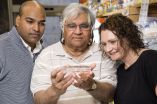(Press-News.org) Many animals, including humans, acquired essential 'foreign' genes from microorganisms co-habiting their environment in ancient times, according to research published in the open access journal Genome Biology. The study challenges conventional views that animal evolution relies solely on genes passed down through ancestral lines, suggesting that, at least in some lineages, the process is still ongoing.
The transfer of genes between organisms living in the same environment is known as horizontal gene transfer (HGT). It is well known in single-celled organisms and thought to be an important process that explains how quickly bacteria evolve, for example, resistance to antibiotics.
HGT is thought to play an important role in the evolution of some animals, including nematode worms which have acquired genes from microorganisms and plants, and some beetles that gained bacterial genes to produce enzymes for digesting coffee berries. However, the idea that HGT occurs in more complex animals, such as humans, rather than them solely gaining genes directly from ancestors, has been widely debated and contested.
Lead author Alastair Crisp from the University of Cambridge, UK, said: "This is the first study to show how widely horizontal gene transfer (HGT) occurs in animals, including humans, giving rise to tens or hundreds of active 'foreign' genes. Surprisingly, far from being a rare occurrence, it appears that HGT has contributed to the evolution of many, perhaps all, animals and that the process is ongoing, meaning that we may need to re-evaluate how we think about evolution."
The researchers studied the genomes of 12 species of Drosophila or fruit fly, four species of nematode worm, and 10 species of primate, including humans. They calculated how well each of their genes aligns to similar genes in other species to estimate how likely they were to be foreign in origin. By comparing with other groups of species, they were able to estimate how long ago the genes were likely to have been acquired.
A number of genes, including the ABO blood group gene, were confirmed as having been acquired by vertebrates through HGT. The majority of the other genes were related to enzymes involved in metabolism.
In humans, they confirmed 17 previously-reported genes acquired from HGT, and identified 128 additional foreign genes in the human genome that have not previously been reported.
Some of those genes were involved in lipid metabolism, including the breakdown of fatty acids and the formation of glycolipids. Others were involved in immune responses, including the inflammatory response, immune cell signalling, and antimicrobial responses, while further gene categories include amino-acid metabolism, protein modification and antioxidant activities.
The team were able to identify the likely class of organisms the transferred genes came from. Bacteria and protists, another class of microorganisms, were the most common donors in all species studied. They also identified HGT from viruses, which was responsible for up to 50 more foreign genes in primates.
Some genes were identified as having originated from fungi. This explains why some previous studies, which only focused on bacteria as the source of HGT, originally rejected the idea that these genes were 'foreign' in origin.
The majority of HGT in primates was found to be ancient, occurring sometime between the common ancestor of Chordata and the common ancestor of the primates.
The authors say that their analysis probably underestimates the true extent of HGT in animals and that direct HGT between complex multicellular organisms is also plausible, and already known in some host-parasite relationships.
The study also has potential impacts on genome sequencing more generally. Genome projects frequently remove bacterial sequences from results on the assumption that they are contamination. While screening for contamination is necessary, the potential for bacterial sequences being a genuine part of an animal's genome originating from HGT should not be ignored, say the authors.
INFORMATION:
Media Contact
Joel Winston
Media Officer
BioMed Central
T: +44 (0)20 3192 2081
E: Joel.Winston@biomedcentral.com
Notes to editor:
1. Research article
Alastair Crisp, Chiara Boschetti, Malcolm Perry, Alan Tunnacliffe and Gos Micklem
Expression of multiple horizontally acquired genes is a hallmark of both vertebrate and invertebrate genomes
Genome Biology 2015
DOI: 10.1186/s13059-015-0607-3
After embargo, article available at journal website here: http://dx.doi.org/10.1186/s13059-015-0607-3
For an embargoed copy of the article, please contact Joel.Winston@biomedcentral.com
2. Genome Biology serves the biological research community as an international forum for the dissemination, discussion and critical review of information about all areas of biology informed by genomic research. Key objectives are to provide a guide to the rapidly developing resources and technology in genomics and its impact on biological research, to publish large datasets and extensive results that are not readily accommodated in traditional journals, and to help establish new standards and nomenclature for post-genomic biology.
3. BioMed Central is an STM (Science, Technology and Medicine) publisher which has pioneered the open access publishing model. All peer-reviewed research articles published by BioMed Central are made immediately and freely accessible online, and are licensed to allow redistribution and reuse. BioMed Central is part of Springer Science+Business Media, a leading global publisher in the STM sector. http://www.biomedcentral.com
Findings from a new study that set out to investigate the evolution of immune defences could boost the development of industrial bacteria that are immune to specific viral infections. The study is published today in the journal Current Biology.
Bacteria have many industrial uses including the production of cheese and yoghurt, paper making, biogas and the synthetic production of hormones like insulin. Viral infections of these bacterial cultures can halt production processes resulting in significant financial cost.
Dr Edze Westra from the Environment and Sustainability ...
LA JOLLA--For infants with severe combined immunodeficiency (SCID), something as simple as a common cold or ear infection can be fatal. Born with an incomplete immune system, kids who have SCID--also known as "bubble boy" or "bubble baby" disease--can't fight off even the mildest of germs. They often have to live in sterile, isolated environments to avoid infections and, even then, most patients don't live past a year or two. This happens because stem cells in SCID patients' bone marrow have a genetic mutation that prevents them from developing critical immune cells, called ...
In a new study, published in Cell Reports, researchers at Uppsala University describe a novel mechanism by which lymphatic vessels form during embryonic development. The finding may open new possibilities for repairing damaged lymphatic vessels using stem cells.
Olof Rudbeck, professor of medicine at Uppsala University, discovered the lymphatic vascular system in the 17th century. A research group at the institute bearing his name, the Rudbeck Laboratory at Uppsala University, has now discovered a novel origin of the lymphatic system.
The prevailing textbook knowledge ...
In 1953 Watson and Crick first published the discovery of the double helix structure of the DNA. They were able to visualize the DNA structure by means of X-Ray diffraction. Techniques, such as electron microscopy, allowed scientists to identify nucleosomes, the first and most basic level of chromosome organisation. Until now it was known that our DNA is packaged by regular repeating units of those nucleosomes throughout the genome giving rise to chromatin. However, due to the lack of suitable techniques and instruments, the chromatin organisation inside a cell nucleus ...
An extensive database identifying immune traits, such as how immune cell function is regulated at the genetic level in healthy people, is reported by researchers from the National Institutes of Health (NIH) and their collaborators in the journal Cell. While many genetic risk factors have been linked to various diseases, including autoimmune disorders, how a genetic change causes susceptibility to a disease is not always clear. By studying healthy people, researchers from the National Institute of Allergy and Infectious Diseases (NIAID) Vaccine Research Center, part of the ...
Ponds in the Arctic tundra are shrinking and slowly disappearing, according to a new study by University of Texas at El Paso (UTEP) researchers.
More than 2,800 Arctic tundra ponds in the northern region of Alaska's Barrow Peninsula were analyzed using historical photos and satellite images taken between 1948 and 2010. Over the 62-year period, the researchers found that the number of ponds in the region had decreased by about 17 percent, while pond size had shrunk by an average of one-third.
"The 17 percent is a very conservative estimate because we didn't consider ...
Being discriminated against by the healthcare profession or system can cause much more than just mere distress to older people. Such experiences can literally be bad for their health. A national survey shows that one in every three older Americans who are on the receiving end of age-related discrimination in the healthcare setting will likely develop new or worsened functional ailments in due course. This follows a study1 led by Stephanie Rogers, a fellow in geriatrics at UC San Francisco in the United States, and published in the Journal of General Internal Medicine2, ...
NEW YORK, NY -Where you receive medical care impacts many things - including whether or not you receive inappropriate medical tests, according to a new study.
Researchers from NYU Langone Medical Center and its Laura and Isaac Perlmutter Cancer Center, in a new retrospective study publishing online March 12th in JAMA Oncology, conclude that patients with low-risk prostate or breast cancer were more likely to receive inappropriate imaging during treatment, based on the region of the country in which they received medical care.
They examined medical records from 2004-2007 ...
An association of high rates of inappropriate imaging for prostate cancer and breast cancer identified in a study of Medicare beneficiaries suggests that, at the regional level, regional culture and infrastructure could contribute to inappropriate imaging, something policymakers should want to consider as they seek to improve the quality of care and reduce health care spending, according to a study published online by JAMA Oncology.
Researchers have estimated that 30 percent of resources spent on health care in the United States does not improve the health of patients. ...
In a group of patients diagnosed with colorectal cancer at 40 or younger, 1.3 percent of the patients carried germline TP53 gene mutations, although none of the patients met the clinical criteria for an inherited cancer syndrome associated with higher lifetime risks of multiple cancers, according to a study published online by JAMA Oncology.
Li-Fraumeni syndrome is an inherited cancer syndrome usually characterized by germline TP53 mutations in which patients can develop early-onset cancers and have an increased risk for a wide array of other cancers including colorectal. ...


